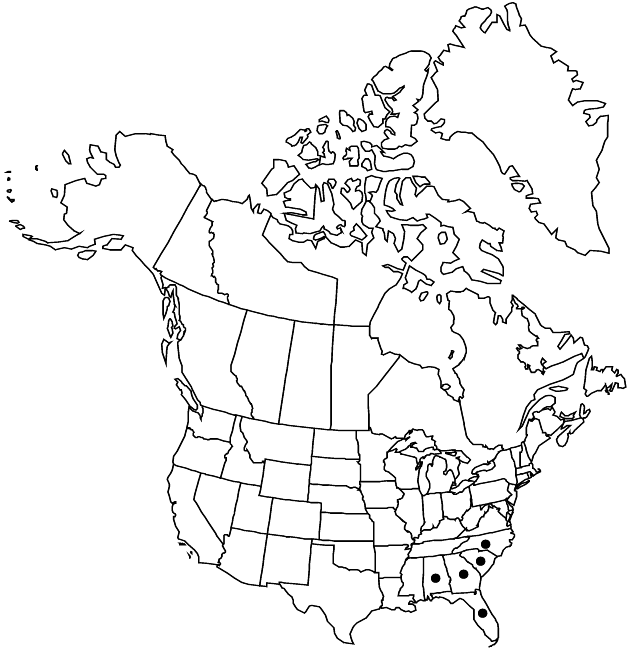Liatris pauciflora
Fl. Amer. Sept. 2: 510. 1813.
Plants 20–90 cm. Corms globose, sometimes depressed or elongate. Stems minutely puberulent-hirtellous (hairs spreading to slightly deflexed) or glabrous. Leaves: basal and proximal cauline 1-nerved, narrowly oblanceolate to linear-oblanceolate, 40–120 × 2–7 mm, gradually or abruptly reduced distally (continuing as linear, mostly 10–40 mm bracts), hispidulous-hirtellous or glabrous, weakly, if at all, gland-dotted (glandular hairs not evident, proximal margins sometimes ciliate). Heads in dense, racemiform to spiciform (strongly secund) arrays. Peduncles 0 or (ascending) 1–8 mm. Involucres cylindric, 11–15 × 4–7 mm. Phyllaries in 3–4 series, mostly oblong to oblong-oblanceolate, unequal, essentially glabrous, margins with hyaline borders, apices acute (sometimes with mucros or apicula). Florets 3–6; corolla tubes pilose inside. Cypselae 3–4.5 mm; pappi: lengths ± equaling corollas, bristles barbellate.
Distribution

Ala., Fla., Ga., N.C., S.C.
Discussion
Varieties 2 (2 in the flora).
Varieties pauciflora and secunda are mostly allopatric, apparently overlapping in south-central Georgia and perhaps northeastern Florida. Some plants of var. secunda in Brunswick County, North Carolina, have nearly glabrous stems; their phyllaries have the narrower shape of more typical plants of the area and glandular punctations are strongly developed. Some plants of var. pauciflora in Seminole and Orange counties, Florida, have slightly hirtellous stems and lack glandular punctations. In other localities, differences in vestiture and punctation are not perfectly correlated. Other differences are seen as tendencies: leaves of var. secunda are thicker than in var. pauciflora and often have strongly but narrowly thickened-revolute margins; inner phyllaries of var. secunda are slightly narrower than in var. pauciflora, and the mid and inner usually are apiculate or mucronulate.
A. Cronquist (1980) treated Liatris pauciflora and L. secunda as a single species, suggesting that they might prove to be Mendelian variants; their mostly allopatric ranges indicate otherwise. Population studies might provide insight into the evolutionary interactions.
Selected References
None.
Key
| 1 | Stems usually glabrous, rarely sparsely hirtellous; leaves (and phyllaries) not or weakly gland-dotted; involucres 11–15 × 4–7 mm; phyllaries: inner (9–)10–13 × 2.5–3.8 mm, apices acute (without mucros or apicula); cypselae 3–4.5 mm | Liatris pauciflora var. pauciflora |
| 1 | Stems minutely puberulent-hirtellous (hairs spreading to slightly deflexed); leaves (and phyllaries) gland-dotted (each pit with a glandular hair); involucres 7–10(–14) × 3–5 mm; phyllaries: inner 10–13 × 2–3 mm, apices abruptly short-acuminate, mid and inner often apiculate to mucronulate; cypselae 4–5 mm | Liatris pauciflora var. secunda |